Cats, celebrated for their hunting skills, are often captivated by the swift and slithering movements of snakes, setting the stage for a real-life drama where the question arises: can cats kill snakes?
This intriguing dance between predator and potential prey harks back to their wild ancestors.
Indeed, when cats encounter snakes, their innate killer instinct can spring into action, particularly in the case of a curious kitten.
Domestic cats have been documented successfully confronting snakes of small to mid-size, while their larger feline counterparts tackle more formidable serpents with notable prowess.
However, it’s crucial to remember that encouraging cats to engage with snakes is not advisable. Snakes do not form part of their natural diet and could pose potential risks to their health.
To ensure the safety and well-being of these adept hunters, sticking to their nutritious and delicious cat food is the best course of action.
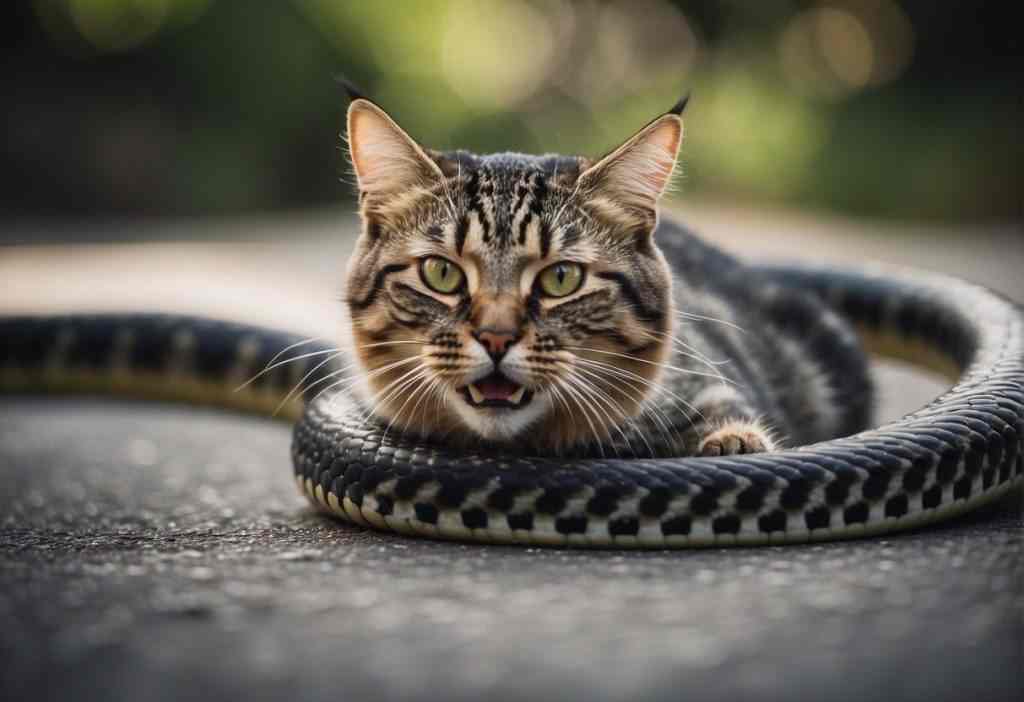
As a cat owner, you must understand this dynamic. Not all encounters between cats and snakes are playful games, and some can turn pretty risky.
While cats are capable of killing snakes, they might come across varieties that pose significant threats, such as venomous species.
On one paw, knowing that your feline might deter some unwanted slithering visitors gives a sense of security.
On the other paw, comprehending the risks involved is essential for the safety of your beloved pet and maintaining the balance with local wildlife in the vicinity.
However, it’s important to note that cats and snakes are unlikely to come into contact in the first place, making the danger of a snake bite low.
Key Takeaways
- Cats possess natural hunting instincts that can drive them to chase and sometimes kill snakes.
- Understanding the interaction between cats and snakes is important for the safety of your pet and wildlife.
- Some encounters with snakes can pose risks to cats, underlining the need for preventive measures.
Can Cats Kill Snakes?
Research shows that cats come with a set of hunting instincts that are as natural to them as purring.
That’s right, your kitty’s urge to chase and hunt for nutrition is innate, not something they pick up from watching other cats or from their environment.
This means even your lazy couch potato feline has the heart of a hunter!
- Inborn Instincts:
Studies suggest that cats have an inborn ability to hunt and stalk prey, which includes snakes. So that intense stare and crouched position? It’s all part of their incredible natural abilities. - Cautious Approach:
When it comes to snakes, cats usually exhibit a strategic, cautious approach. They spend time observing their potential prey ensuring they don’t end up on the losing side of the encounter.
Veterinarians offer insight into this intriguing aspect of feline behavior, noting both risks and benefits:
- Risks:
Engaging with snakes isn’t without its dangers. Venomous snakes pose a real threat to your cat’s health, underscoring the importance of cautious interactions. (1) - Benefits:
Engaging in predatory behavior can provide mental and physical stimulation for your cat, which is always a plus for their well-being.
There you have it! Your cat’s predatory behavior is deeply programmed into their genes, just as much as their love for lounging in sunny spots.
Remember, this stealthy side of their nature is as fascinating as it is complex, and always worth observing—safely, of course.
Types of Snakes Encountered by Cats
Let’s dive into the serpentine world your cat might be exploring.
Common Non-Venomous Snakes:
- Garter Snakes:
Often found slinking through your garden, these are the harmless neighbors that your cat may play with. (2) - Ribbon Snakes:
Similar to garters but with a sleeker build, ribbon snakes are another common non-threatening species. (3)
Venomous Snakes to Watch Out For:
- Rattlesnakes:
Packs a serious punch with their venomous bite, and their rattle is a sign for your cat to back off. (4) - Copperheads:
Camouflaged and venomous, they’re a risk to cats, especially in wooded areas. (5)
But where your cat lives makes a big difference!
If you’re in an urban setting, the chance of crossing paths with a snake is generally lower—fewer hiding spots for our scaly friends. But an occasional garter snake in the park isn’t unheard of.
However, move into a rural locale, and the story changes. With more space and plenty of places to hide, encounters with a variety of snake species shoot up.
Your cat might be more likely to bump into venomous ones, where they might need to use their nine lives.
Did You Know? In some areas, snakes are quite prolific! In rural zones, you might find a snake every few hundred meters, especially if you’re talking about those pesky non-venomous types.
But those statistics flip on their head in cities, where development keeps the snake population much lower.
Remember, while your cat’s curiosity is high, so is their instinct to stay safe. So next time you see them pounce, they might just have met one of these snakey characters!
Keep an eye out, stay informed, and let’s keep both our whiskered hunters and their reptilian counterparts safe.
Risks and Safety Concerns
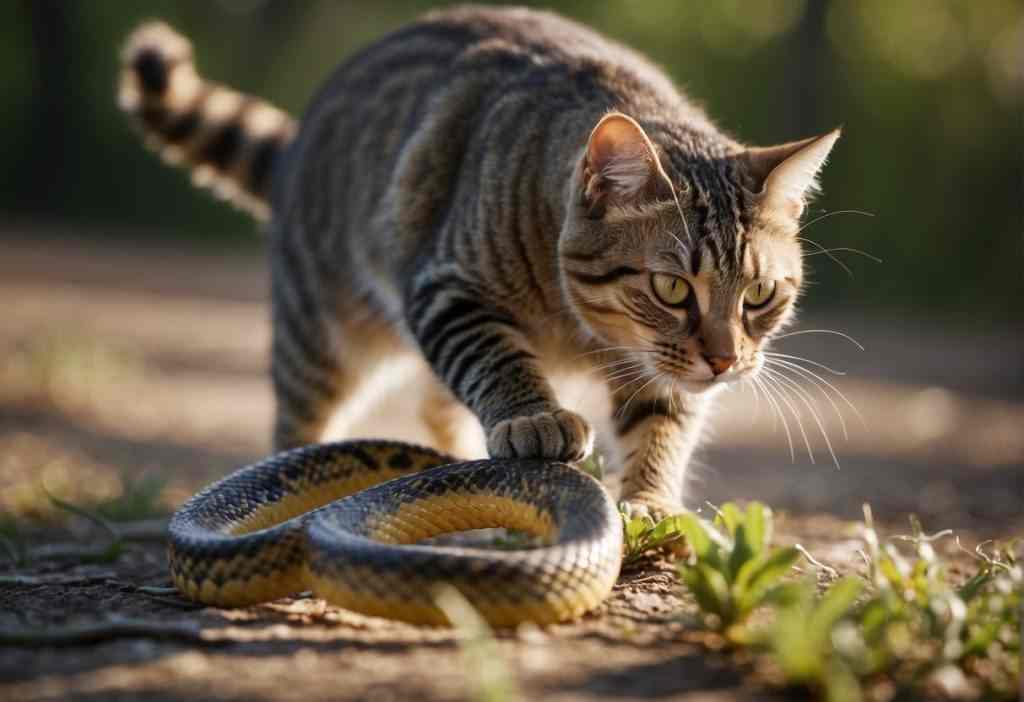
When Cats Eat Snakes
It’s crucial to consider the health risks involved, especially if the snake is poisonous. When cats tackle snakes, they’re not thinking about parasites or the danger of snake venom.
Just like eating a toxic plant or other food, eating a poisonous snake can cause sickness and some of the same symptoms that happen after a serpent bite. It’s a bit of a cat-and-mouse game, only with higher stakes!
So, let’s be vigilant about these slithery encounters and the potential toxins they may carry and consider the best course of action. Here are some final thoughts on what to do if your cat eats a snake.
Immediate Veterinary Care for Snake Bites
Time is of the essence, and knowing the signs of venom poisoning could save your pet’s life. Look out for:
- Sudden weakness
- Visible puncture marks
- Swelling or bruising
- Pain and agitation
- Difficulty breathing
Here’s a quick guide for first aid:
- Keep calm and your cat still; minimizing movement slows venom spread.
- Avoid home remedies or sucking out venom—it’s not a superhero movie!
- Don’t apply ice or a tourniquet; it can cause more harm than good.
- Transport your cat to the vet immediately; professional care is non-negotiable.
When at the vet, treatments might include antivenom, pain relief, and supportive care.
Remember, no challenge is too great for you as a pet owner—stay informed, stay prepared, and give your cat the superhero support they deserve! Now, let’s keep those adventurous paws safe, shall we?
Preventive Measures and Safety Tips
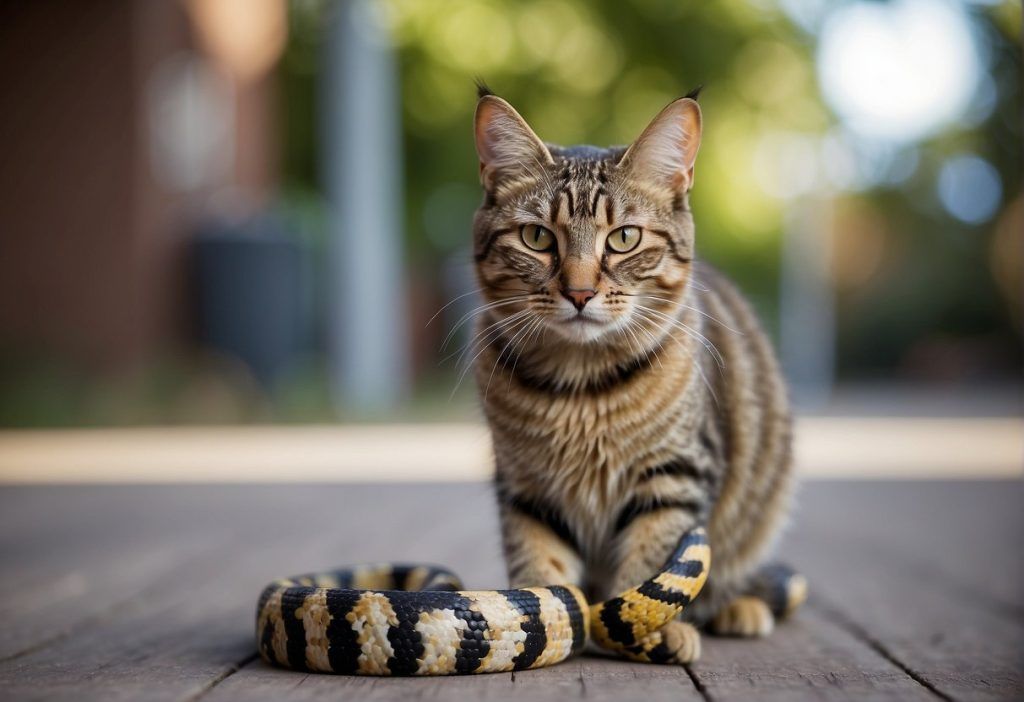
Let’s chat about how you can create a snake-free zone to protect your curious cat.
Securing Their Territory
First things first, consider keeping your cat indoors during dawn and dusk. That’s prime time for snakes, and it’s best if your kitty isn’t out there making risky introductions.
- Outdoor Precautions: If your cat loves the great outdoors, make sure your yard is less inviting to snakes.
This means:
- Keeping grass short
- Removing clutter like rocks and woodpiles
- Using snake-proof fences if you’re in a snake-prone area
- Keeping grass short
Spotting Trouble
You know your cat’s behavior better than anyone. Watch out for signs they might have met a slithery foe:
- Changes in Behavior:
Is the kitty being unusually aggressive or skittish? That could point to a snake encounter. - Possible Bite Symptoms:
Swelling or sudden pain reactions are urgent cues to get your feline to a vet, pronto!
Remember, while your fearless hunter might think they’ve got everything under control, it’s up to you to keep them out of harm’s way. Keep an eye out, stay vigilant, and here’s to a snake-free life for your whiskered pal!
Cats’ Interaction with Snakes
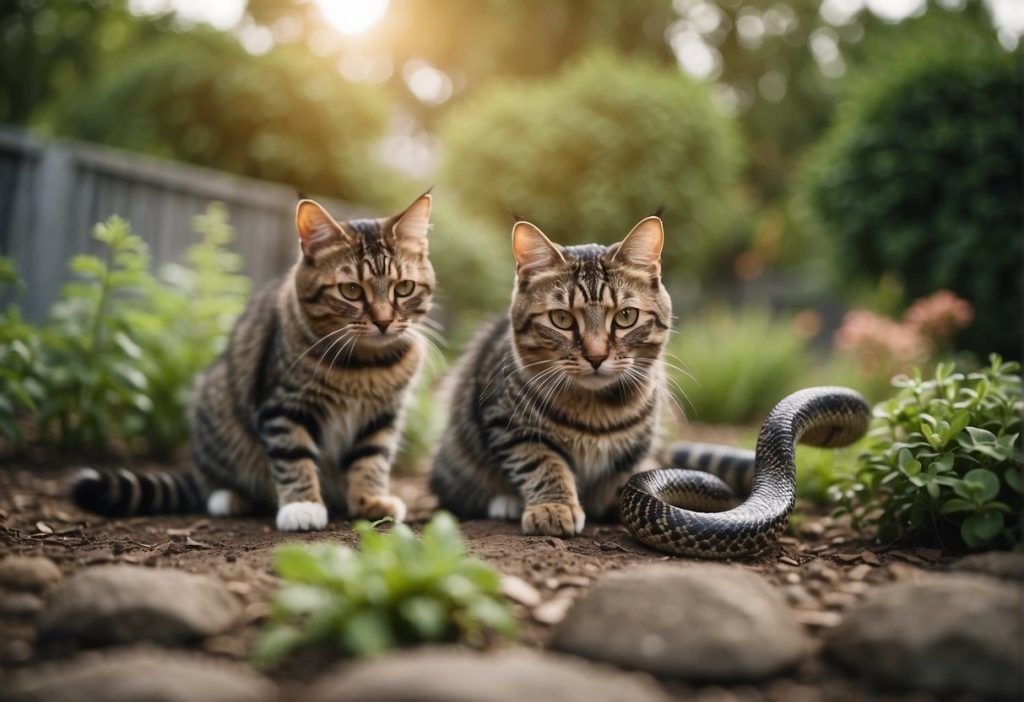
Cats, being the curious and agile hunters they are, often find snakes intriguing.
What drives this fascination? It’s partly their natural hunting instinct—the way snakes move and their distinct texture can signal a chase game to a cat.
Cats can reach speed bursts of 30mph, clearly outrunning the likes of common backyard snakes, like rattlesnakes which max out at about 3mph.
However, it’s important to note that snakes have fast reflexes and can attack back, making it crucial for cats to have quick reflexes and agility to successfully hunt and defend themselves.
Natural Hunting vs. Playful Curiosity
Some cats are more inclined to hunt due to their inherent predatory nature. They see a snake’s movements and can’t resist pouncing. But not all cats have the same level of interest.
For some, snakes are a mere curiosity, inspected from a safe distance—or perhaps not deemed worthy of attention at all.
However, if a cat does decide to hunt and kill a smaller snake, there may be remnants left behind that can be unpleasant for us to find.
It usually takes some time for a cat to kill a snake because the hunt is like a game to them, and they enjoy playing with their prey before going in for the kill.
However, cats have been known to successfully hunt and kill smaller snakes such as the king snake, the garter snake, and the gopher snake.
However, it is important to note that not all cats are capable of killing and eating snakes, as it also depends on their size, breed, and hunting skills.
Behavioral Training and Adaptation
Wondering how to prevent your cat from tangling with these reptilian neighbors? Here’s a nugget of advice: positive reinforcement works wonders.
- Introduce controlled exposures to teach them that snakes aren’t toys.
- Reward them with treats or their favorite playtime for opting out of the chase.
Remember, while many domesticated cats can and do kill snakes, this can put them at risk, especially if the snake is venomous or particularly large.
It’s always best to encourage a game of feather-on-a-string instead of an encounter with a slithery guest for the first time. Your kitty’s safety is paramount, after all!
Whether your cat is a brave hunter or the cautious type, it’s clear that these interactions with snakes are a dance between curiosity and the age-old art of predation.
Stay safe, keep an eye out, and help your little hunter navigate their world, both indoors and out.
Keeping Your Cat Safe from Snakes
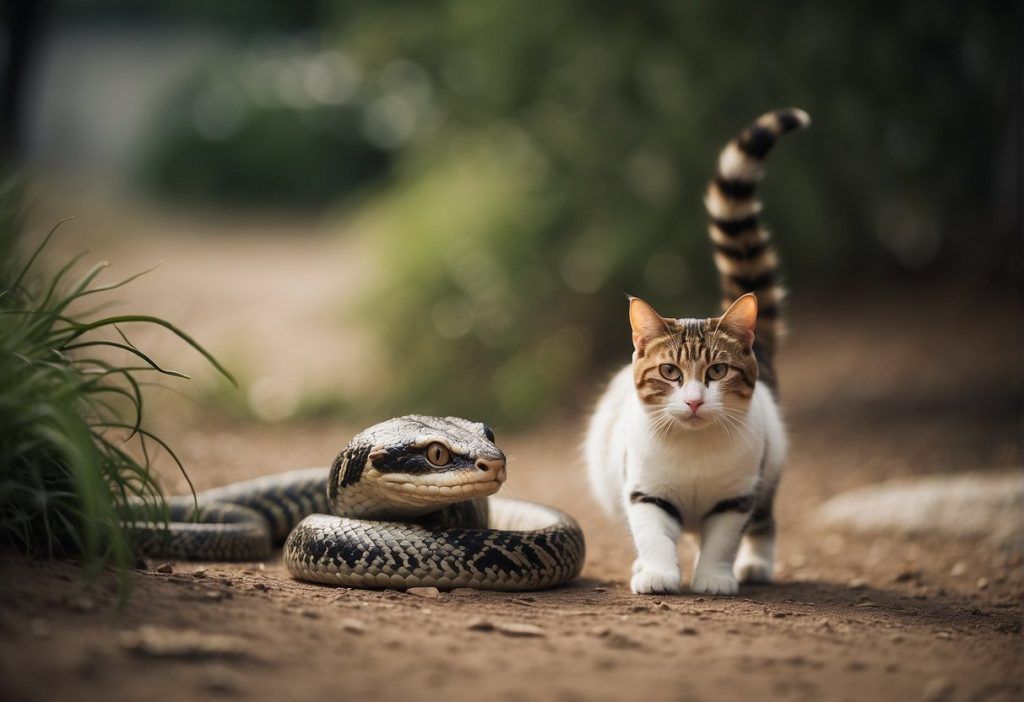
Snakes can be a real concern, especially if you live in an area they frequent. But fear not! With a few proactive steps, you can keep your furry friends safe from slithery creatures while they explore the great outdoors.
This includes inspecting all of your window and door screens in the house to make sure they are secure and free of any openings that a cat could slip through, and installing pet doors to provide indoor access without the risk of snakes and other unwanted critters.
Be sure to also keep open windows to a minimum, as they can also pose a risk for snakes to enter your home.
Additionally, removing any potential hiding spots for snakes such as rock piles, water features, and untrimmed shrubbery can help keep your cat safe from encounters with these reptiles.
Safety Measures for Outdoor Cats:
- Cat Enclosures:
Your cat can enjoy the sunshine in a secure outdoor cat enclosure, also known as a “catio.” This way, they get the best of both worlds – fresh air and safety! - Habitat Removal:
Snakes love to hide in clutter. Keeping your yard tidy by clearing away debris, tall grass, and rocks reduces snake-friendly spots. - Supervision:
Keep an eye on your kitty when they’re out and about, especially during snake season.
First Aid for Snake Bites:
- Keep Calm:
Both you and your cat! Panicking can increase the heart rate, spreading venom faster. - Immobilization:
Gently limit your cat’s movement to slow the spread of any potential venom. - Wound Care:
Do not wash the bite or attempt to suck out the venom. Keep the bite site below heart level. - Seek Vet Care:
Time is crucial. Head to your vet or an emergency animal hospital immediately, even if the snake isn’t venomous.
Remember, these slinky reptiles usually prefer a retreat over confrontation. Yet, if a curious paw pokes around their hiding spot, it’s better to be safe than sorry.
Tailor these tips to the snake savvy you need for your locale and keep your fur baby’s adventurous spirit worry-free!
Quick Recap
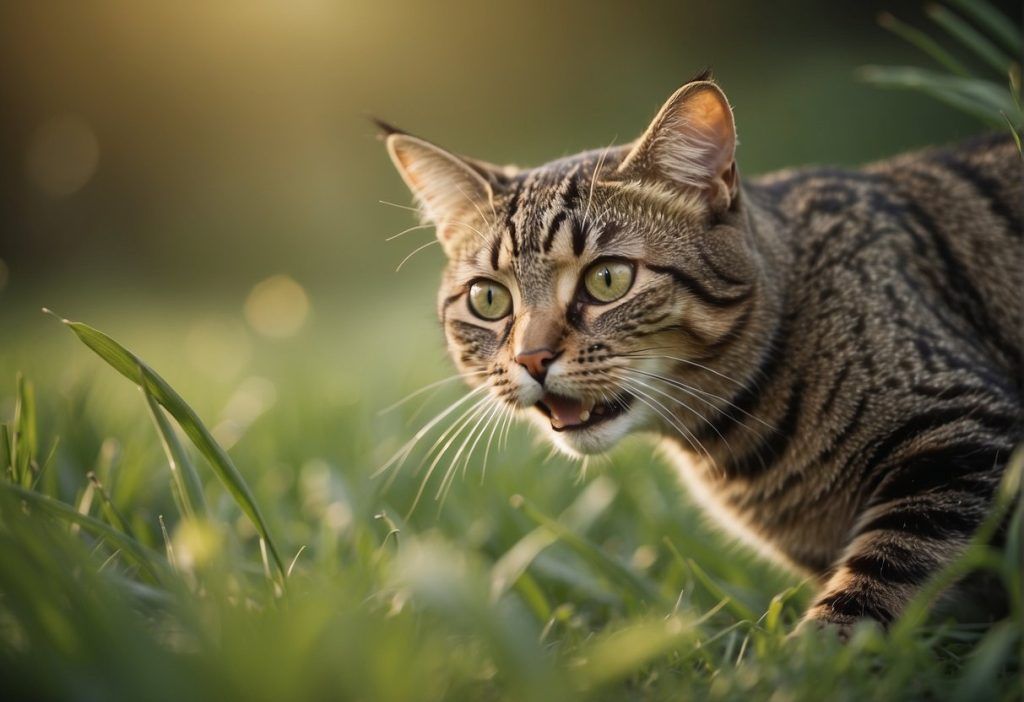
Let’s break down the nitty-gritty.
Natural hunters by design, they’re quick on their paws and have sharp claws and teeth ready to pounce.
They vary, and size does matter here. Your cat might intimidate a small garden snake, but a large, venomous serpent is a different story.
On the speedometer, cats can sprint up to 30mph, showing off their agility and top speed. Snakes? Not so fast – a rattlesnake may hit 3mph, with some species slithering up to 12mph.
Here’s a brief rundown:
- Instincts: Cats have them!
- Size Matters: The bigger and worse the snake, the riskier for your pet.
- Speed Showdown: Cats might win the race, but not always the battle.
As a pet owner, it’s key to be clued in on the local wildlife. Live where snakes are more than just a hissy fit on TV? It’s about balancing your cat’s predator side with their safety.
Keep your eyes peeled and education ongoing. Whether it’s supervising outdoor adventures or brushing up on snake smarts, you’ve got this!
Remember, it’s not about cutting the thrill of the chase but ensuring the chase doesn’t end in a vet trip.
So, there you have it! Just another day in the life of your feline’s wild world. Stay safe and happy prowling!
Frequently Asked Questions
Navigating the complex interactions between cats and snakes can be full of surprises! Let’s clear up some common queries so you’re informed and your feline friend stays safe.
Can all cats kill snakes, or does it depend on the cat’s size and breed?
Your cat’s ability to tackle a serpent intruder largely hinges on its size and the snake’s size.
While breed isn’t a primary factor, a larger cat might have a confidence boost when facing off against small, non-venomous snakes.
Are certain snake species more dangerous to cats than others?
Venomous snakes pose a significant risk to your kitty.
Snakes like vipers and cobras can be especially dangerous, and an encounter with them could lead to serious harm.
How can I tell if my cat has been bitten by a snake?
Keep an eye out for puncture wounds, swelling, or sudden weakness.
Cats bitten by a venomous snake may also display symptoms such as drooling, vomiting, or breathing difficulties.
What should I do immediately if I suspect my cat has been bitten by a snake?
Time is of the essence. Keep your cat calm and still, as movement can accelerate the spread of venom, and rush them to the nearest vet.
Quick action can be a game-changer for your cat’s recovery.
Is it safe to let my cat outside if I live in an area with many snakes?
Evaluate the risk. If your area teems with venomous snakes, outdoor adventures come with increased danger.
Consider leash-walking your cat, or creating a secure catio to keep them safe from slithery visitors.
Can indoor cats also encounter snakes, and how can I prevent this?
Snakes can sometimes sneak indoors, especially into basements or ground-level apartments.
To prevent unwelcome encounters, seal any gaps in your home’s exterior and keep windows and doors closed or screened.
Do cats naturally avoid venomous snakes, or can they not tell the difference?
Cats may not distinguish between venomous and non-venomous snakes purely on sight.
Curiosity could put them at risk, so it’s best to err on the side of caution and prevent any potential face-offs.


